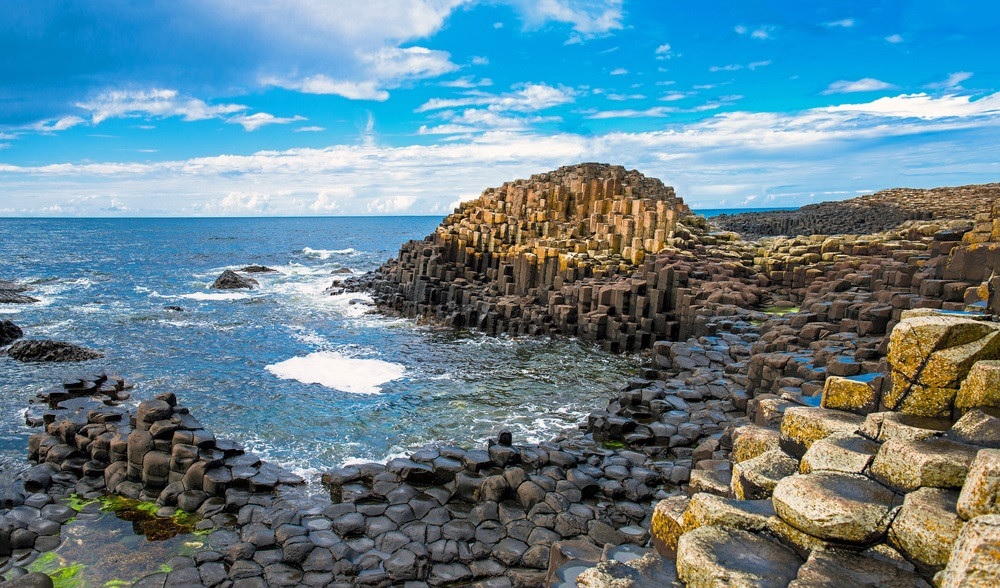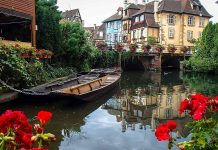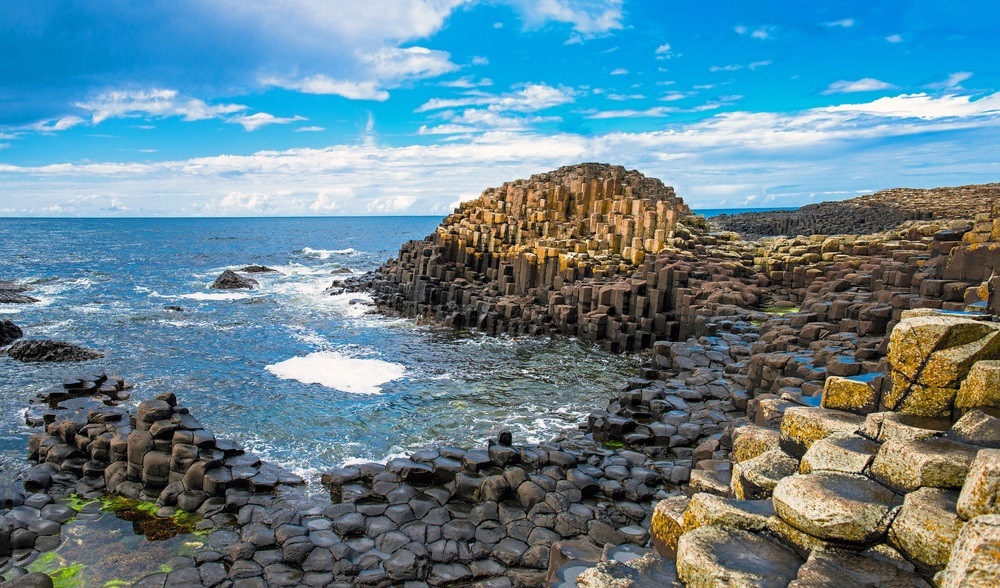
Northern Ireland’s Giant’s Causeway: Witness a Natural Wonder & Step into Game of Thrones Landscapes
Northern Ireland’s Antrim Coast holds a spectacle that defies belief and fuels imagination: The Giant’s Causeway. This UNESCO World Heritage Site isn’t just a geological marvel; it’s a portal to ancient myths and, for millions, the dramatic landscapes of Westeros itself. Prepare to walk on 60 million-year-old hexagonal stones and tread the ground where iconic scenes from Game of Thrones unfolded.
A Geological Masterpiece Forged by Fire and Ice
Forget smooth beaches; the Causeway presents a surreal vista of approximately 40,000 interlocking basalt columns, mostly hexagonal, descending like colossal stepping stones into the churning Atlantic. This astonishing formation is the work of intense volcanic activity during the Paleogene Period, around 50-60 million years ago.
- The Fiery Birth: Molten basalt lava erupted through chalk beds, forming a vast lava plateau. As this immense pool of lava cooled rapidly upon contact with the air and perhaps seawater, it contracted and fractured.
- Nature’s Precision Engineering: The contraction wasn’t random. Similar to how mud cracks as it dries, the cooling lava created a network of fractures propagating downwards. The result? A remarkably organized structure of predominantly hexagonal pillars (though pentagons, heptagons, and octagons also appear), often towering up to 12 meters (39 feet) high. This process, known as columnar jointing, created one of the most perfect and extensive examples on Earth.
- Distinctive Features: Explore the site to discover named formations like the Giant’s Boot (a massive, boot-shaped block), the Organ (a set of tall, vertical pipes resembling organ pipes), and the Wishing Chair (a natural throne-like arrangement). The Amphitheatre, where the columns curve dramatically, is particularly breathtaking.
Finn McCool: Where Geology Meets Legend
The science is awe-inspiring, but the legend is enchanting. Local folklore attributes the Causeway to the Irish giant Fionn mac Cumhaill (Finn McCool).
- The Rival Giant Story: Finn, living on the Antrim Coast, was challenged to a fight by the Scottish giant Benandonner across the sea. To reach his foe, Finn tore chunks from the cliffs and built a causeway across the North Channel. However, upon seeing the immense size of Benandonner approaching, Finn’s wife, Oonagh, devised a clever ruse. She disguised Finn as a baby in a cradle.
- The Clever Ruse: When Benandonner saw the size of the “baby,” he reasoned that its father must be truly colossal. Fearing confrontation with such a giant, Benandonner fled back to Scotland, destroying much of the causeway behind him to prevent pursuit. The remnants left behind are what we see today – on both the Irish and Scottish coasts (notably Fingal’s Cave on Staffa).
Stepping onto the Sets of Game of Thrones: The Causeway Coast as Westeros
The raw, dramatic beauty of the Causeway Coast made it the perfect stand-in for the rugged, often perilous landscapes of Westeros in HBO’s Game of Thrones.
- The Causeway Itself: While not a specific named location, the otherworldly atmosphere and unique geology perfectly embody the fantastical essence of the Seven Kingdoms. Walking among the columns, you can easily imagine dragons soaring overhead or armies marching along the coast.
- Nearby Filming Locations (The Real “Game of Thrones Land”): The Causeway sits at the heart of filming country. Just a short drive along the stunning Causeway Coastal Route reveals iconic spots:
- Larrybane Quarry (Carrick-a-Rede): This dramatic headland near the famous rope bridge served as Renly Baratheon’s Camp in Season 2, where Catelyn Stark parleyed and Brienne of Torth pledged her service.
- Ballintoy Harbour: The picturesque, sheltered harbour transformed into Lordsport Harbour on the Iron Islands, home of House Greyjoy. The key scene where Theon Greyjoy returns to Pyke was filmed here.
- Dunluce Castle (Ruins): Perched precariously on cliffs a few miles west, these evocative ruins inspired the Castle of Pyke, seat of House Greyjoy. While exterior shots used various castles, Dunluce’s dramatic setting perfectly captures Pyke’s essence.
- Downhill Strand (Beach) & Mussenden Temple: This vast beach below the iconic clifftop temple was the setting for Dragonstone Beach, where Melisandre burned the Seven idols and where Varys met Melisandre in Season 7. The temple itself evokes the Dragonstone fortress look.
- The Dark Hedges: A short drive inland, this haunting avenue of intertwined beech trees became the Kingsroad, famously traversed by Arya Stark escaping King’s Landing.
Experiencing the Giant’s Causeway: A Practical Guide
- Visitor Centre: Start at the award-winning, eco-sensitive Visitor Centre. Its interactive exhibits delve deep into the geology, legends, history, and biodiversity of the area. This is also where you book tickets (highly recommended, especially in peak season).
- Accessing the Stones: From the centre, you can walk down the scenic cliff path (approx. 20-25 mins downhill, longer return) or take the frequent shuttle bus (small fee). The walk offers stunning coastal views.
- Exploration: Once on the basalt platform, explore freely! Walk on the columns, marvel at the formations, listen to the waves crash, and breathe in the salty air. Allow at least 2-3 hours, more if you hike the cliff paths.
- Guided Tours: Consider a guided tour (available from the Centre or local operators) for deeper geological insights and captivating storytelling about Finn McCool.
- Essential Tips:
- Wear Sturdy Footwear: The basalt stones can be uneven and slippery, especially when wet. Hiking boots or strong trainers are essential.
- Dress in Layers: Coastal weather is notoriously changeable. Waterproof and windproof outer layers are crucial, even on sunny days.
- Check Tide Times: While the main causeway is accessible at most tides, some areas might be cut off or more dangerous at high tide.
- Respect the Site: Stay on designated paths where required. Do not climb excessively on the columns (beyond normal walking) to preserve this fragile wonder.
- Combine with the Coastal Route: The Giant’s Causeway is the crown jewel of the Causeway Coastal Route. Plan time to visit Carrick-a-Rede Rope Bridge, Dunluce Castle, the Dark Hedges, and Bushmills Distillery.
A Journey Through Deep Time and Epic Fantasy
The Giant’s Causeway is more than just a collection of stones. It’s a testament to the immense power of our planet, a canvas for ancient storytelling, and a breathtaking stage for modern fantasy. Standing on those geometric pillars, feeling the Atlantic spray, you stand simultaneously amidst geological forces millions of years old, the footsteps of mythical giants, and the dramatic world of dragons and direwolves. It’s an experience that blends natural wonder, cultural heritage, and pop culture magic into one unforgettable destination – truly a cornerstone of any journey to Northern Ireland. Witness the wonder, embrace the legend, and walk into the realm of Game of Thrones.





















